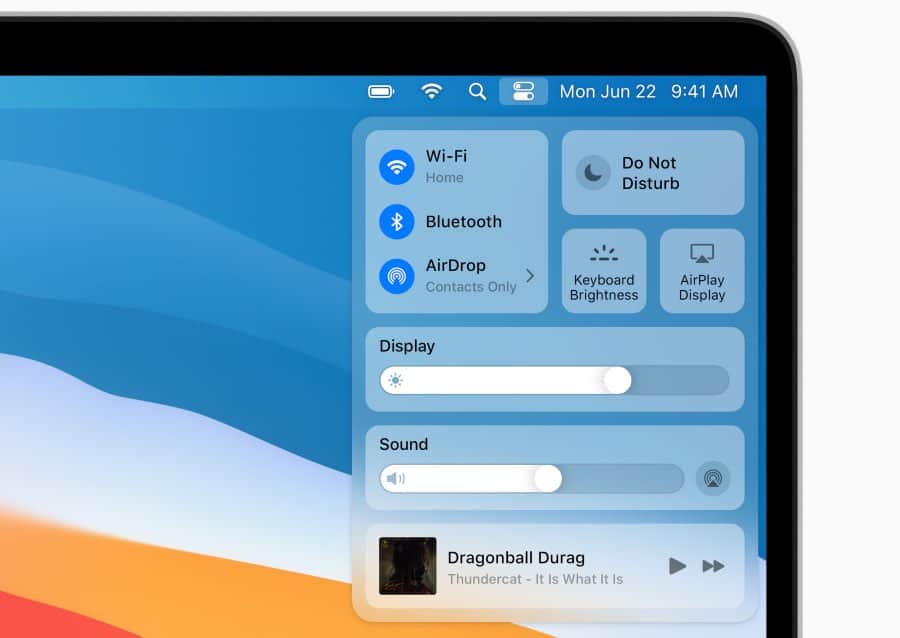
Above: If that new Control Center in MacOS Big Sur looks familiar, it’s because it’s been around on the iPad for a while. Images courtesy Apple.
BitDepth#1258 for July 16, 2020
At this year’s Worldwide Developer’s Conference, Apple undertook another major platform migration for its line of computers, a switch from Intel’s CPUs to its own ARM-based chips, now dubbed, with characteristic hubris, Apple Silicon.
Company representatives demonstrated versions of its next operating system release, Big Sur, running on versions of the chips it has been developing for its iPhone and iPads in tower hardware.
Developers were invited to sign up for a programme that includes a Mac Mini running the chip that also powers its top of the line iPad Pro.
Apple has traditionally smoothed these issues over with emulation technology, which runs older software in a code environment that fakes being an older computer system.
As a long-time user of Macs, I’ve been through all the major system migrations, beginning with the move from 68K based chipsets to PowerPC chips from IBM, from the disruptive OS9 to OSX migration, which completely changed the software underpinnings of the Mac. Then on to the switch from PowerPC chips to Intel CPUs.
Twenty-four months from now, Apple plans to declare Intel based Macs a part of its history, and what lies ahead is a shift in both hardware and software that’s going to be challenging, at best.
It’s the company’s second attempt at basing it’s operating system on Reduced Instruction Set Computing or RISC, which gave the early PowerPC chips a significant leap in computing power with lower power draw.
Intel chips use a different architecture, Complex Instruction Set Computing or CISC.
RISC had its beginnings in a chip designed by Acorn Computers which was so stingy on power that when it was first tested, it ran on residual electricity on the early computer’s logic board even when it wasn’t turned on.
The technology is now licensed by Advanced RISC Machines (ARM) and appears in every mobile phone and tablet made today.
ARM is the secret behind today’s computer grade handheld devices, which sport battery life that handily trumps that of even the most carefully designed laptop.
CISC thrived where power wasn’t an issue, such as in desktop systems and workstations.
As the two have inexorably drawn closer together, it seemed inevitable that the increasing power and useful power management of mobile devices would make its way into, at the very least, lightweight portable computers.

For Apple, the move will merge its chip manufacturing business with its computer designs, but it will also bring even more dovetailing of its operating systems for handheld devices and computers, which have been incrementally growing ever more similar to each other.
But there will be hiccups. Some apps won’t make the transition.
Apple has traditionally smoothed these issues over with emulation technology, which runs older software in a code environment that fakes being an older computer system.
For the most part it works, except for when it doesn’t.
But Apple has gotten very good at emulation over the years of software and hardware migration.
Toward the end of the OS9 emulation era with Snow Leopard, its first major software emulation tool, Rosetta, had evolved into an almost invisible feature of the operating system.
Expect Rosetta 2, the new emulation tool that will run old software on ARM chips to be at least as good.
And it’s not as if there aren’t already ARM chips in Macs. Apple has been quietly integrating ARM based chips into Macbook for years to offload OS services from the CPU and GPU to dedicated hardware.
Should you buy a new Mac now? If you don’t need one, then don’t. New ARM based Macs are likely to appear in less than a year.
If you do, then go ahead. There’s likely to be some demand for Intel-based Macs as the transition proceeds, so buy at the high-end to hold resale value.
It took more than five years for PowerPC Macs to fade from use after 12 years in production and Intel-based Macs have been manufactured since 2006.


